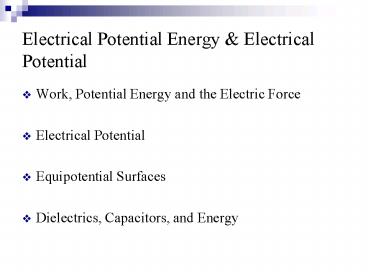Electrical Potential Energy - PowerPoint PPT Presentation
1 / 29
Title:
Electrical Potential Energy
Description:
Electrical Potential Energy & Electrical Potential. Work, Potential Energy and the Electric Force ... Work done by the electrical force: Net work = D kinetic ... – PowerPoint PPT presentation
Number of Views:41
Avg rating:3.0/5.0
Title: Electrical Potential Energy
1
Electrical Potential Energy Electrical Potential
- Work, Potential Energy and the Electric Force
- Electrical Potential
- Equipotential Surfaces
- Dielectrics, Capacitors, and Energy
2
Electrical Potential Energy Electrical Potential
- Work, Potential Energy and the Electric Force
- Electrical Potential
- Equipotential Surfaces
- Dielectrics, Capacitors, and Energy
3
Work, Potential Energy, and the Electric Force
- Consider a positive charge q, moving west through
a displacement S at a constant velocity in a
region occupied by a uniform eastward electric
field E.
4
Work, Potential Energy, and the Electric Force
- The charge experiences an eastward electric
force. For it to move at constant velocity, an
equal westward force is required.
5
Work, Potential Energy, and the Electric Force
- Work done by the westward force
- Work done by the electrical force
- Net work D kinetic energy zero
6
Work, Potential Energy, and the Electric Force
- The electric force is conservative. Its work
does not change the energy of the object. - The westward force is nonconservative. Its work
changes the total energy
7
Work, Potential Energy, and the Electric Force
- The increase, qES, in the energy of the object is
- electrical potential energy (EPE).
- Like any other form of energy, it has SI units of
joules (J). - Every conservative force is associated with a
form of potential energy.
8
Work, Potential Energy, and the Electric Force
- The work done by the forces is the same, even if
we go from the starting to the ending point by a
meandering path. Work done by a conservative
force is path-independent.
9
Work, Potential Energy, and the Electric Force
- The increase in electrical potential energy (EPE)
is also unaffected by our choice of path. D EPE
depends only on E, q, and the endpoint locations.
10
Work, Potential Energy, and the Electric Force
- Call the endpoints of our travel A (beginning)
and B (end). - Travel from A to B with a test charge q0.
- Divide through by q0
11
Work, Potential Energy, and the Electric Force
- Define a new quantity, electrical potential
- and
- SI units of electrical potential
12
Electrical Potential Energy Electrical Potential
- Work, Potential Energy and the Electric Force
- Electrical Potential
- Equipotential Surfaces
- Dielectrics, Capacitors, and Energy
13
Electrical Potential
- Since weve talked about the electrical potential
of points A and B, lets look at what that means.
Consider a positive point charge, Q, and a point
A that is a distance r from Q
14
Electrical Potential
- What is the electrical potential at point A?
- To answer that question, we need to know how much
work is required to bring a test charge from a
point infinitely distant from Q, to point A.
15
Electrical Potential
- The force required to move the test charge at a
constant velocity is not constant with the
distance x from Q - In fact, the force isnt even linear with x so
we cant calculate and use an average force.
16
Electrical Potential
- Calculating the potential at point A is a
calculus problem. The work required to move the
test charge an infinitesimal distance dx is dW
17
Electrical Potential
- Integrate to calculate W
18
Electrical Potential
- The potential of a point is relative to zero
potential, which is located infinitely far away. - When more than one charge is present, the
potential is the algebraic sum of the potentials
due to each of the charges, individually. - Electric potential is not the same thing as
electrical potential energy.
19
Electrical Potential
- Gravitational
Electrical - Another way to express the magnitude of the
electric field as a potential gradient
20
Electrical Potential Energy Electrical Potential
- Work, Potential Energy and the Electric Force
- Electrical Potential
- Equipotential Surfaces
- Dielectrics, Capacitors, and Energy
21
Equipotential Surfaces
- Equipotential surface a collection of points
that all have the same electrical potential.
22
Equipotential Surfaces
- The electric field vector is everywhere
perpendicular to equipotential surfaces. Why?
23
Equipotential Surfaces
- The electric force does no work on charges moving
on an equipotential surface. Why?
24
Electrical Potential Energy Electrical Potential
- Work, Potential Energy and the Electric Force
- Electrical Potential
- Equipotential Surfaces
- Dielectrics, Capacitors, and Energy
25
Dielectrics, Capacitors, and Energy
- Consider a parallel-plate capacitor, with a
charge q and a plate area A, the plates separated
by a distance d. The internal electric field - A constant electric field E, and a distance d
between the plates, gives the potential
difference between the plates
26
Dielectrics, Capacitors, and Energy
- Solve for the ratio of the charge to the voltage,
and define a new quantity, capacitance - SI units coulomb/volt C2/J farad (F)
27
Dielectrics, Capacitors, and Energy
- Dielectric material fancy term for an insulating
material. - Separation of surface charge causes a reduction
of the internal electric field by a factor of k,
the dielectric constant
28
Dielectrics, Capacitors, and Energy
- Fill the capacitor with a dielectric
- Its capacitance is increased by a factor of k,
the dielectric constant.
29
Dielectrics, Capacitors, and Energy
Springs Capacitors
Work is required to compress a spring Work is required to charge a capacitor
Work per unit length increases linearly with compression Work per unit charge increases with the amount of charge
Energy Energy































